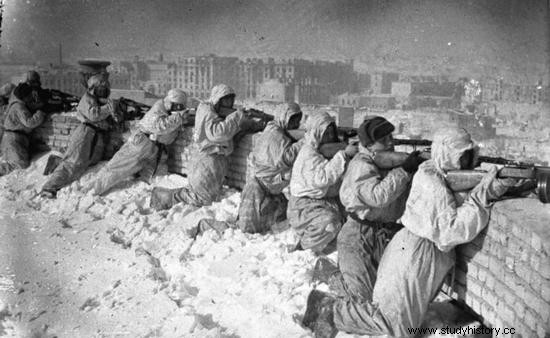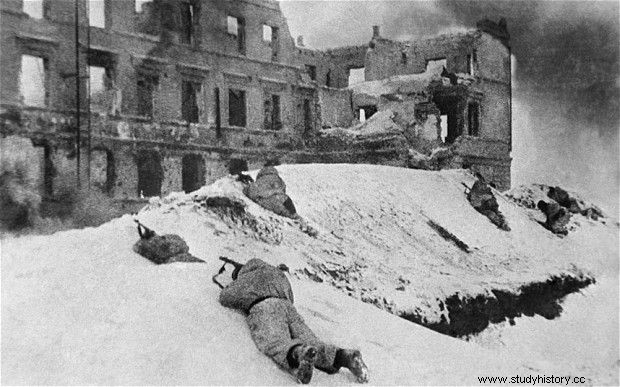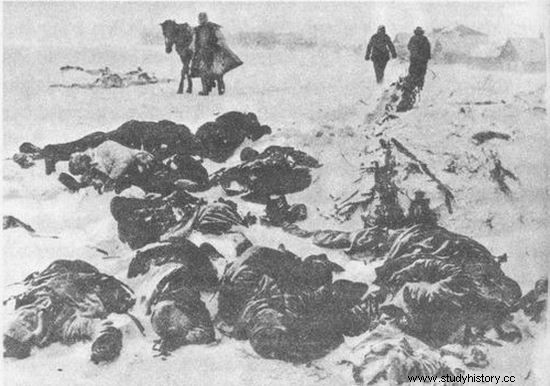Winter is coming, but thanks to our article, you don't have to worry about arctic temperatures. These people fought for their lives every day against the enemy and against the worst weather. Who could give you better lessons in dealing with frost?
All you have to do is push the door and the whole rotten building will collapse with a crash . Adolf Hitler's words just before Operation Barbarossa show well the disrespect for the army of the Soviet Union. From the German point of view, it was supposed to be another victorious and quick campaign.
Within a few months, the Wehrmacht troops planned to destroy the Red Army, and swastikas were to hang in the Kremlin. The self-confidence lost the Germans, who went to war unprepared for the Russian frosts, and at the same time sure that they would end it ... wearing short sleeves.
Bavarian shorts vs. Grandpa Frost
On the other side of the front, the situation was also not rosy. It would seem that the Soviets should be perfectly prepared to fight the frost. Especially after the experience of the war with Finland. The facts, however, show something else. Some divisions of the Red Army (especially Siberian ones) had excellent winter equipment. Everyone else was poorly prepared for the arrival of Grandfather Frost.
In particular, warm hats and gloves were missing. The clothing that the Red Army was given turned out to be better than the German winter uniforms. Padded pants and jackets were highly appreciated and desired by both warring parties. Under these difficult conditions, improvisation was the basis of survival.

During severe frosts, appropriate clothing is essential. These Red Army soldiers have nothing to complain about. In such uniforms, no frosts will scare them (source:Bundesarchiv; lic. CC ASA 3.0).
The bucket that saved a life!
A good trench is essential for survival in war. Due to the frozen ground, Soviet soldiers dug pits only 40–50 cm deep. The finished dugout was covered with a tarpaulin. You could only lie in such a shelter. Preferably side by side, like canned sardines . People slept on one side, and sometimes the frost was so strong that it was possible to frostbite not only the fingers or the nose, but even half of the body. For this reason, one of the soldiers from time to time gave the command: we twist .
Whenever possible, a bucket stove was made, which saved lives during the coldest frosts. Such a source of heat not only kept you warm, but also cheered you up and raised your morale. You could put your feet up to the stove. This is how the valons were dried (warm, mid-calf shoes, impermeable to water).
The stench coming out of the Russian footwear was shocking, but in the war you can get used to everything. Some soldiers burned a telephone cord to illuminate the "luxury quarters", which smelled terribly and tarnished faces.
In the morning, the soldiers coughed up tar black saliva. A certain sergeant major, seeing that one of his comrades is going to him, all soiled, said: I don't know, you are going forward with your face or butt ... (Quoted after N. Nikulin, Sołdat ).
The shoe does not come off? We're going to chop my leg off!
What did every Wehrmacht soldier fighting on the Eastern Front dream about? About the Führer's handshake? About the bed warmed up by Helga's wife? Not necessarily. Each of them was tormented by an obsession:to get a Russian sheepskin coat!
It was a very warm and well-cut jacket. Such clothes were used by the Soviet Siberian divisions, which mostly fought on the front lines. Fryce (as the Russians used to say about the Germans) obtained these jackets by taking them off the slain Soviet soldiers.

Ruins and snow, or everyday life for those who fight in Stalingrad.
However, not everything could be downloaded. The problem was with walonki, which would not come off the foot of the frozen corpse for any treasure. That's why a German soldier came up with the idea to chop off the dead legs. He then transported them to the bathhouse and thawed them there.
Probably not the only one who showed similar ingenuity. It was, moreover, one of the least macabre ways to fight the frost. When the temperature dropped to 30 or 40 degrees below zero, the soldiers on both sides of the front got really creative ...
Some Germans were so desperate that they killed the loitering dogs. Then they skinned them and made them into what looked like gloves. Jackets were made of horse skin. Such homemade "clothing" was stiff to wear, but it did its job:it protected against the paralyzing cold.

An image of poverty and despair, i.e. a Romanian soldier from Stalingrad. His uniform was clearly not suitable for the Soviet frosts.
Soviet onuce instead of cap
During severe frosts, the famous German helmet became like a freezer compartment. To remedy this, the soldiers wrapped their heads with whatever was at hand. They were often scarves or wrappers. Even underwear or Russian onuces were used for this purpose (a piece of linen or cotton flannel fabric used in place of socks).
Many German soldiers, who were encircled by the Russians at Stalingrad, did not receive their proper clothing on time. Therefore, they had to improvise. The soldiers who were in the open steppe had the worst. Often it was impossible to make a trench. The ground was so cold that fires were lit to soften it a little.
Wood was the scarce material. Therefore, when a country cottage found itself in the area, it was immediately dismantled. The boards and beams obtained in this way were used to make the roof of the dugout. The Russian owners were expelled and left to fend for themselves. Of course, they had previously taken their warmer clothes. In most cases, they had no chance of survival.
Swollen? We're cutting it off!
It is impossible to estimate the number of soldiers who died as a result of severe frosts. Soldiers were almost always doomed to their own ingenuity. The German commanders cared more for their subordinates. They were provided with a special yellow ointment for frostbite. This one did not always help.

At Stalingrad, the frost was the toughest among the soldiers fighting in the steppe.
The fingers on the hands were sometimes so swollen that they could barely fit into the trigger guard, so that the unfortunate man could not even use a weapon. Gangrene often happened and the only option was to have a limb amputated.
The proud Aryans, who went to fight in the name of Hitler, did not manage to overcome the Russian winter. With their limbs cut off and their heads wrapped in captured Soviet onuces, they went into captivity.
Were it not for the fact that in the East "such a climate", history could have developed completely different ...
